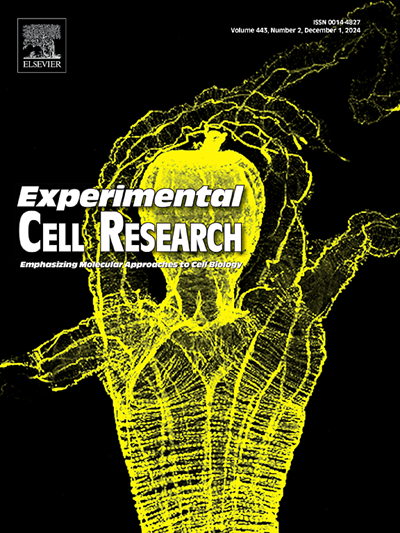糖酵解相关基因特征及P4HA1在骨肉瘤预后中的功能作用
IF 3.3
3区 生物学
Q3 CELL BIOLOGY
引用次数: 0
摘要
骨肉瘤是一种主要影响儿童和青少年的原发性恶性骨肿瘤,其特征是有氧糖酵解,这与肿瘤的进展和转移有着复杂的联系,但其预后意义仍未得到充分探讨。本研究旨在利用糖酵解相关基因建立骨肉瘤预后模型,并阐明该模型中的关键基因P4HA1在骨肉瘤预后和免疫细胞浸润中的功能作用。我们收集了UCSC Xena和GEO数据库中骨肉瘤患者的临床和转录组学数据。通过单因素Cox和LASSO回归分析,我们确定了12个糖酵解相关基因显著影响骨肉瘤预后。利用这些基因构建风险评分模型,通过生存分析和ROC曲线准确预测患者预后,预测1年、3年和5年生存的AUC分别为0.899、0.881和0.878。该模型在不同的临床亚组中特别有效。免疫细胞浸润分析显示,CD8+ T细胞、naïve CD4+ T细胞、静止树突状细胞和活化肥大细胞对模型的预测能力有显著贡献。该模型还显示免疫相关信号通路显著富集,表明免疫状态与骨肉瘤预后中糖酵解相关风险评分之间存在密切关联。值得注意的是,P4HA1在骨肉瘤组织中上调,并以糖酵解依赖的方式促进细胞增殖,如P4HA1过表达的骨肉瘤细胞内ATP水平升高、葡萄糖吸收抑制和乳酸水平升高。糖酵解抑制剂2-DG可显著减弱P4HA1对细胞增殖的促进作用,表明P4HA1作用对糖酵解的依赖性。总之,我们通过整合糖酵解相关基因建立了骨肉瘤的预后模型,特别强调了P4HA1的功能作用。我们的发现强调了糖酵解和免疫细胞浸润在疾病预后中的相互作用。该模型为靶向治疗提供了新的思路,为骨肉瘤治疗的进一步研究奠定了基础。本文章由计算机程序翻译,如有差异,请以英文原文为准。
Glycolysis-related gene signatures and the functional role of P4HA1 in osteosarcoma prognosis
Osteosarcoma, a primary malignant bone tumor predominantly affecting children and adolescents, is characterized by aerobic glycolysis, which is intricately linked to tumor progression and metastasis, yet its prognostic implications remain underexplored. This study aimed to develop a prognostic model utilizing glycolysis-related genes and to elucidate the functional role of P4HA1, a key gene within this model, in osteosarcoma prognosis and immune cell infiltration. We collected clinical and transcriptomic data from osteosarcoma patients in the UCSC Xena and GEO databases. Through univariate Cox and LASSO regression analyses, we identified 12 glycolysis-related genes that significantly influence osteosarcoma prognosis. These genes were employed to construct a risk score model, which accurately predicted patient outcomes as demonstrated by survival analysis and ROC curves, with an AUC of 0.899, 0.881, and 0.878 for 1-year, 3-year, and 5-year survival predictions, respectively. The model was particularly effective across different clinical subgroups. Immune cell infiltration analysis revealed that CD8+ T cells, naïve CD4+ T cells, resting dendritic cells, and activated mast cells significantly contributed to the model's predictive power. The model also showed significant enrichment of immune-related signaling pathways, indicating a robust association between immune status and glycolytic-related risk scores in osteosarcoma prognosis. Notably, P4HA1 was upregulated in osteosarcoma tissues and promoted cell proliferation in a glycolysis-dependent manner, as evidenced by increased intracellular ATP levels, inhibited glucose absorption, and elevated lactate levels in P4HA1-overexpressing osteosarcoma cells. The promotion of proliferation by P4HA1 could be significantly attenuated by the glycolysis inhibitor 2-DG, highlighting the glycolysis dependency of P4HA1's action. In conclusion, we developed a prognostic model for osteosarcoma by integrating glycolysis-related genes, with a particular emphasis on the functional role of P4HA1. Our findings highlight the interplay between glycolysis and immune cell infiltration in disease prognosis. This model provides insights for targeted therapies and a foundation for further research into osteosarcoma treatment.
求助全文
通过发布文献求助,成功后即可免费获取论文全文。
去求助
来源期刊

Experimental cell research
医学-细胞生物学
CiteScore
7.20
自引率
0.00%
发文量
295
审稿时长
30 days
期刊介绍:
Our scope includes but is not limited to areas such as: Chromosome biology; Chromatin and epigenetics; DNA repair; Gene regulation; Nuclear import-export; RNA processing; Non-coding RNAs; Organelle biology; The cytoskeleton; Intracellular trafficking; Cell-cell and cell-matrix interactions; Cell motility and migration; Cell proliferation; Cellular differentiation; Signal transduction; Programmed cell death.
 求助内容:
求助内容: 应助结果提醒方式:
应助结果提醒方式:


